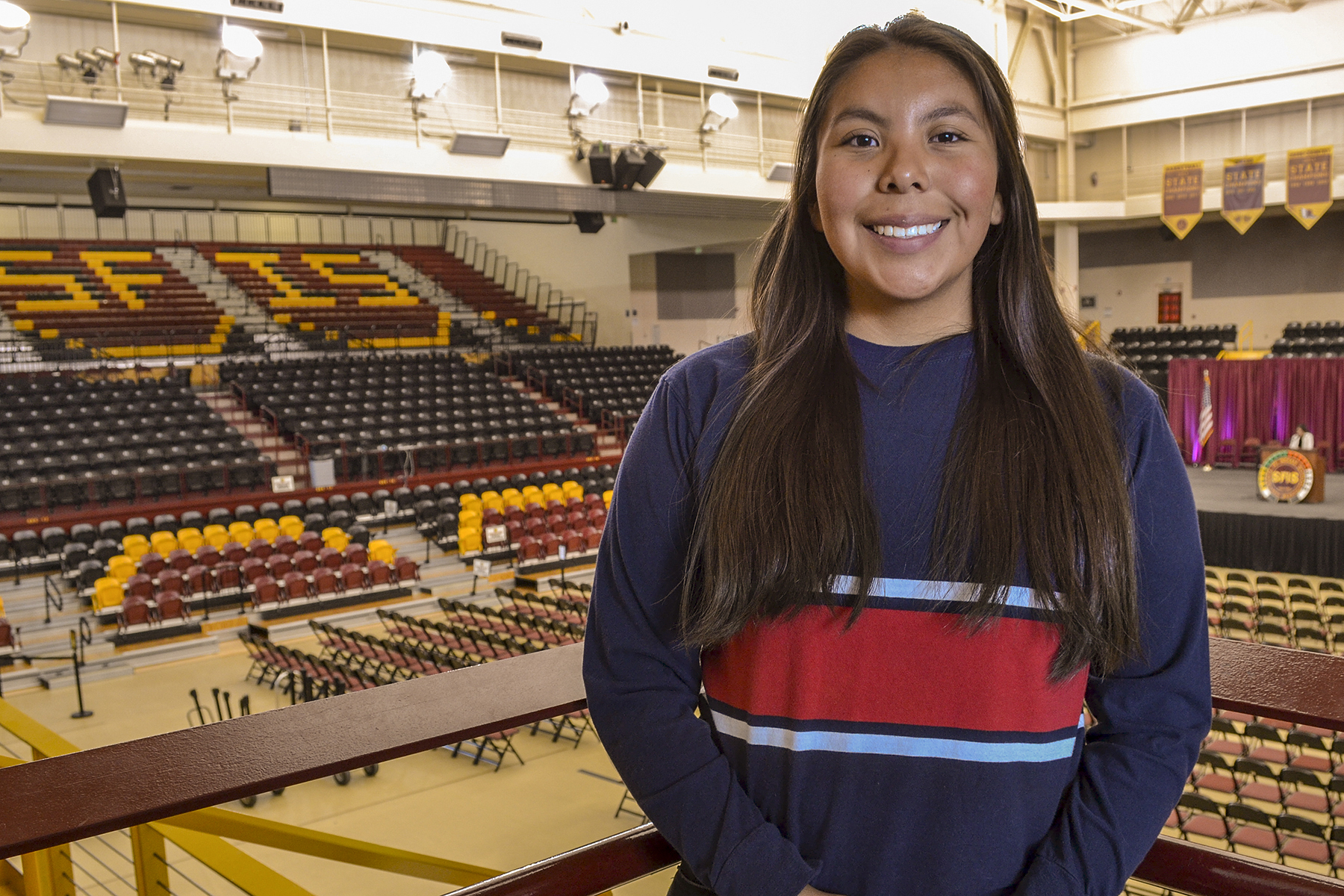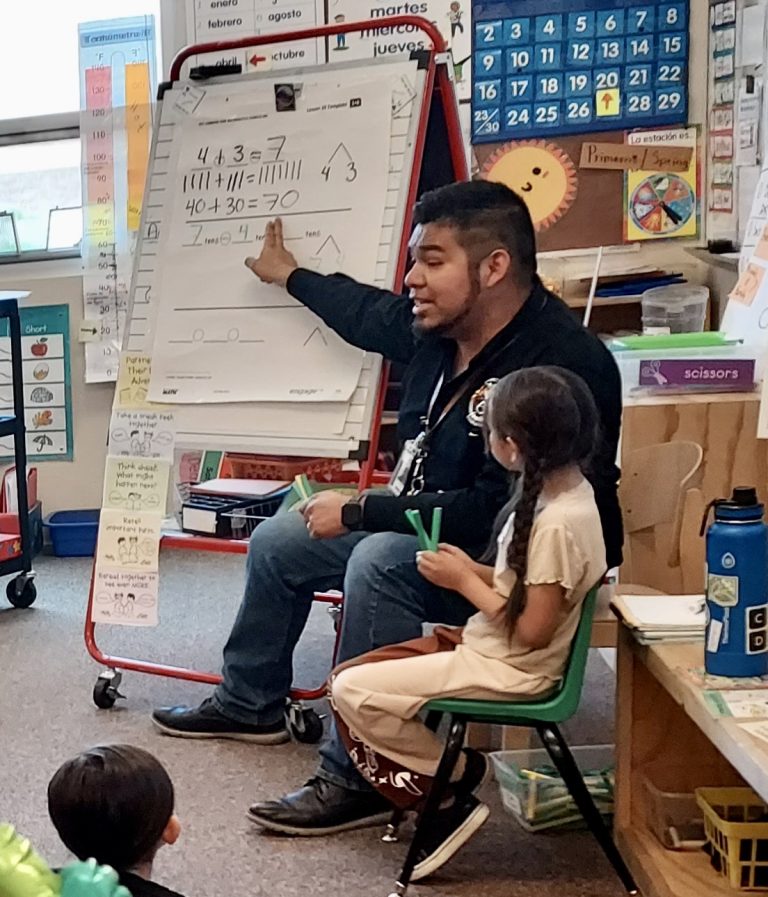Caitlyn Cruz was in the softball dugout lacing her cleats when she got the call that she was the recipient of a $10,000 John & Marti Browne Leadership Scholarship from the LANL Foundation and Los Alamos Employees’ Scholarship Fund (LAESF). It was fitting that she got the good news at a softball tournament. Many of her leadership and team-building skills were developed while playing softball, forming sisterly bonds with her teammates over pregame pasta dinners and cheering each other on during games.
Cruz, a 2019 graduate of the Santa Fe Indian School (SFIS), is studying chemistry and environmental sciences at the University of Redlands in California, inspired in part by her Senior Honors Project (SHP). She spent a year researching composting for the project and then brought her ideas to her own school cafeteria, her Pueblo, and the local elementary school and took action. She got the seed of the idea when she joined the SFIS Green Team, a club that looks for ways to make the school more environmentally friendly. She noticed a big problem with the composting system in the cafeteria: the school didn’t benefit from the compost they produced.
“We don’t get the compost back, which really bugged me,” said Cruz. “I found out that the composting facility sells it. So it’s not even remotely coming back.”
The Santa Fe Indian School is located on a sprawling campus with plenty of land and a greenhouse, so the rich material could have many uses.
“As Native Americans, we used to use every single part of an animal. And now it’s hard to believe that we don’t use every single part of our food,” she said. “I wanted to just take action within my community and use the compost to plant our own food.”
Bringing the composting plan to the tribal administration
After doing some initial research on the best composting practices around the world, she brought her ideas to a weekly tribal council meeting in Ohkay Owingeh.
“I gave a presentation and said that if every person in our community contributed to the compost, we’ll get so much organic fertilizer that we won’t even need to go to our store to buy the produce that we use for Feast,” said Cruz. “There’s a couple of Pueblo farmers that have to use chemical fertilizer for their crops. I emphasized that if we all do this, we can give back to the farmers and have them give back for the Feast. It was just kind of a full circle type thing.”
She wanted to make sure the community leaders supported her idea, so when they served lunch, she brought out her composting bins and asked everyone to separate their leftover food to make compost out of it.
When the Pueblo started composting, they immediately started saving money on their garbage disposal.
“We’re tired of wasting all this food!”
In March, she brought her composting bins to the Ohkay Owingeh Community School.
She said, “I had them come line up and slowly separate their green beans from their bread and their macaroni. It was so cool to see, because you wouldn’t expect kids to be into it. I got to explain to them that composting will eventually turn into fertilizer and become food again. They were so happy about composting. They were being kids and learning at the same time.”
The staff also loved it, and she got lots of comments like, “We’re tired of wasting all this food. It’s nice to see somebody coming in to take advantage of it.”
The school also saw a decrease in their garbage rates, because they stopped throwing away so much food.
Global compost research showed that simple is better
“During my research, it hit me that we waste so much,” said Cruz. “Australia wastes 900 pounds of food per person each year, and they have a population of over 24 million. We have more than 300 million people here, and we waste about a thousand pounds of food per person. And it’s just so shocking to see that. We could be doing so much better.”
After studying successful composting facilities in Illinois and Hawaii, one thing was clear: they enjoyed a high participation rate because they made it as simple as possible for their community members. “It doesn’t have to be complicated at all,” said Cruz. “All we have to do is participate and it’s going to be successful.”
A portion of the SHP projects involves making global connections. Cruz said, “Once we learn about how other people do things, we can bring it back. In Beijing, they used science to make composting more modern and more convenient in their everyday lives. I incorporated that into my whole project. If we use these influences from other countries, we can make it convenient in our own community.”
Support from teachers, the school and the community
“Ms. Salvatierra really influenced me,” said Cruz. “I had her for Algebra II, for Pre-calc and then for Calculus. And she’s just so inspiring to me. There are certain kids that I’ve had in my math class since middle school, and it’s cool since we kind of grew up with each other in the same classroom. She really pushed us no matter what we did. And we stepped up the level each time.”
“Mr. Santistevan had a big influence on me as well,” said Cruz. “I had him freshman year for physical science, and he really opened my mind to the environmental problems we’re facing and got me more involved in it. And he was my mentor my whole senior year with my SHP project.”
Looking back, Cruz is grateful for how well the Santa Fe Indian School and Ohkay Owingeh have supported her and prepared her for a career in STEM. She said, “They provide all their students with multiple opportunities to go on to bigger things.”
Some of the experiences that helped shape her goals were traveling to conferences as a member of the American Indian Science and Engineering Society, having hands-on learning experiences through the Green Team and the Robotics Club, and making a detailed business plan for a farmer’s market (complete with a compost system), as part of a youth employment program with Ohkay Owingeh where she made a business plan for a farmer’s market (complete with a compost system). Before going to college she participated in a LANL internship in the Environmental Protection and Compliance Division.
She chose the University of Redlands because they have several programs that she is interested in, including their environmental and study abroad programs. She is looking for a change of scenery and a chance to meet a diverse group of new people but also appreciates they have their own Native American program, led by someone from San Ildefonso.
She said, “I feel comfortable going there. I visited there and I really loved it. I just want to learn new things, meet new people, and eventually bring everything I learn back to my community to benefit everybody here.”
Caitlin Cruz and softball coach Oliver Torres in front of the SFIS trophy case. “It’s been amazing to coach Caitlyn. “She’s a good leader and role model, the perfect person to represent the Indian School.”
Story by Mandy Marksteiner; photos: LANL Foundation, Andrea Neal
About LAESF & How to Donate
The Los Alamos Employees’ Scholarship Fund began in 1998 and gets its name from the main source of donations: Los Alamos National Laboratory employees, contractors, and retirees. Donations also come from community members and local businesses that value education and economic development in the region. The scholarship program and funds are managed and administered by the nonprofit LANL Foundation. Award selections, student outreach, and programmatic support are provided by an advisory committee of volunteer donors.
Lab employees may donate year-round to a variety of funds through the LANL Giving Tool. LANL Foundation also accepts direct contributions at www.lanlfoundation.org/give and assists donors in creating individual endowed awards with defined selections criteria.
The Impact of Triad Funding
LANL Foundation funding from Triad doubled the number of $10,000 Leadership Scholarships in 2019 from 10 to 20, supporting hardworking, innovative students like Caitlyn Cruz who lack the financial means to go to college without student loans or the need to balance a heavy course load with employment. Before heading to college, she worked as an intern at LANL in the Environmental Protection and Compliance Division, another benefit of being a LANL Scholar.
“Triad funding aligns with our vision that scholarships serve a diverse, representative, engaged and supported community of LANL Scholars that represents the core values of achievement, leadership and service,” said Mike Ammerman. “Increasing the number of awards for students with demonstrated high-need, means that those with the most significant financial obstacles to get to college are supported.”
For more information, contact LANL Foundation Scholarship Program Manager Mike Ammerman at scholarships@lanlfoundtion.org or 505-753-8890 ext. 115.



